Drilling into ceramic tile can feel intimidating. One wrong move and you risk cracked tiles, jagged holes, or costly repairs. Whether you’re installing bathroom fixtures, mounting shelves in a tiled kitchen, or adding accessories to a backsplash, the key to success is choosing the best drill bit for ceramic tile. Unlike wood or drywall, ceramic tile is hard, dense, and brittle—meaning a standard drill bit just won’t cut it (literally).
Specialized drill bits designed for tile—often tipped with carbide or diamond coatings—make the job safer, cleaner, and far more efficient. The right bit won’t just protect your tiles; it’ll also save you time, reduce frustration, and ensure your finished project looks professional. But with so many options available, how do you know which one to pick? That’s where this buying guide comes in.
Buying Guide: How to Choose the Best Drill Bit for Ceramic Tile

1. Material of the Bit
- Carbide-tipped bits: Affordable and strong, best for softer ceramic tiles and occasional DIY use.
- Diamond-tipped bits: Premium choice for harder ceramic, porcelain, or glass tiles. They cut cleaner, last longer, and are preferred by professionals.
👉 Rule of thumb: For everyday ceramic tile, carbide may suffice. For tougher jobs or frequent drilling, diamond is the way to go.
2. Bit Shape & Design
- Spear-point/tile bits: Feature a sharp, spear-like tip for piercing glazed ceramic without slipping.
- Hole saw bits: Designed for larger openings (like plumbing or fixtures), often diamond-coated.
- Multi-purpose bits: Some can drill through tile, glass, and stone, but always check manufacturer recommendations.
3. Size of the Bit
Choose a size that matches your project:
- Small (⅛”–¼”) for wall plugs, screws, and mounting brackets.
- Medium (⅜”–½”) for anchors and shelves.
- Large (¾”–2”+) for pipes, faucets, or shower fixtures (best with diamond hole saws).
4. Drill Compatibility
Not all bits fit every drill:
- Standard bits work with corded or cordless drills with variable speed settings.
- For harder tiles, use a drill with low RPM and high torque for better control.
- Avoid using hammer drills—impact force can shatter ceramic.
5. Durability & Lifespan
A cheap bit may get through one or two holes, but if you’re working on a full bathroom remodel, you’ll need a more durable option. Diamond-coated bits generally outlast carbide several times over.
6. Cooling & Lubrication
Tile drilling generates heat. Look for bits designed for wet drilling (with water cooling), which prevents overheating, reduces dust, and extends bit life.
7. Budget Considerations
- Carbide tile bits: Budget-friendly ($5–$15 for a set).
- Diamond bits: More expensive ($15–$50+), but worth it for cleaner cuts and longevity.
- For larger projects, investing in a quality diamond bit set usually pays off in time and fewer broken tiles.
👉 By weighing material, size, durability, and compatibility, you’ll be equipped to choose the best bit for drilling ceramic tile—ensuring smooth cuts and professional results every time.
1. Drilax 10-Piece Diamond Drill Bit Set (1/4″ to 2″) with Water Guide & Case

Product Description
The Drilax 10-Piece Diamond Drill Bit Set is a comprehensive kit designed primarily for cutting clean holes in hard surfaces like ceramic tile, glass, stone, and countertops. The set includes hole saws ranging from ¼-inch up to 2″—in total 10 sizes—making it flexible for various plumbing, electrical, or decorative fixture installations. It comes with a water guide, which helps channel water to the drilling site to cool the bit and reduce heat buildup. Also included is a case for organizing the bits. The bits have a 3/8″ shank, which fits most standard handheld drills. This set is intended to handle both wet and dry drilling (though wet is better for longer life), especially for hole sizes. Users expect clean, precise holes, especially in ceramic tile and glass where chipping is a concern.
Key Features
- Hole saw sizes from ¼-inch to 2″ (10 bits total).
- Diamond coating on cutting edges for hard surfaces.
- Water guide included to help with cooling/drainage during drilling.
- 3/8″ standard shank for compatibility with most drills.
- Comes with a storage case to keep bits organized and protected.
Pros
- Wide range of hole sizes in one set—good for multiple uses, plumbing, lights, etc.
- Diamond edges give cleaner cuts, less chipping around the tile, compared to carbide-only hole saws.
- Water guide helps reduce heat which prolongs bit life and preserves tile integrity.
- Solid build overall; many reports say it holds up well if used correctly.
- Storage case is useful to keep track of sizes (often one of the pain points with bits sets).
Cons
- Larger holes (near 2″) require more careful handling—more torque, more heat, and more chance of binding or chipping if not supported.
- For dry drilling, diamond edges still degrade faster; wet drilling required for serious longevity.
- Bits are more expensive than simple carbide bits.
- Might be overkill if you only ever need one or two small holes.
Recommendation
If you’re undertaking a project that needs multiple hole sizes in tile or similar hard surfaces—maybe for fixtures, plumbing, or lighting penetrations—this set is one of the best all-round choices. Especially good if you have or plan to use a water feed or guide to keep bits cool. If you just need one small bit for occasional use, it might be more than you need.
2. Ceramic Tile Glass Drill Bits Set 10-pcs 6mm Spear-Pointed Tungsten Carbide
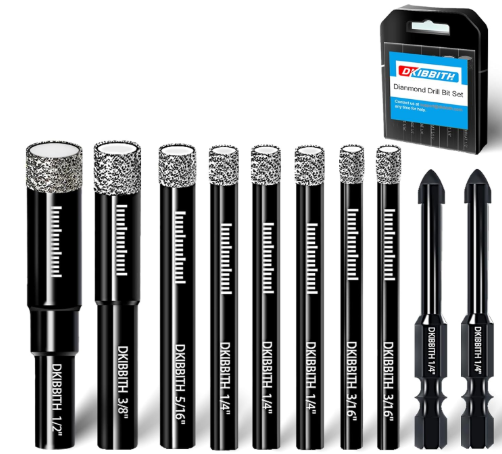
Product Description
This is a 10-piece set of spear-point tungsten carbide drill bits, all at 6mm diameter. The spear‐point design helps start the hole in glazed tile or similar smooth surfaces without slipping. They are marketed for drilling into ceramic tile, bathroom wall tile, mirrors, marble, and glass. Because the size is uniform, this set is good for tasks where matching or replicating several similar holes is necessary (e.g., mounting multiple hooks, towel bars, etc.). It’s a simpler set compared to full hole-saw kits, focusing on narrow, precise drill holes rather than large openings.
Key Features
- 10 bits, 6mm diameter each, spear-point tungsten carbide tips.
- Designed for ceramic tile, bathroom wall tile, mirror, marble, glass surfaces.
- Uniform size, which simplifies consistency when multiple holes are needed.
- Likely lower cost than full size kits or diamond hole saw sets.
Pros
- Good for precision work where you need many similar small holes.
- Spear-point tip helps reduce slipping on glazed/grout surfaces.
- Carbide is more affordable than diamond options; for light duty work this is a sensible option.
- Easy to store; small bits take up little space.
Cons
- Uniform size means lack of flexibility; no ability to drill larger holes (for pipes, fixtures, etc.).
- Carbide degrades faster than diamond when drilling through harder tile or many holes.
- Need to go slow; risk of breaking tip if too much pressure or incorrect speed.
- No water guide or cooling wax; heat buildup is a concern.
Recommendation
This set is ideal if your project involves many small, repeat holes of the same size—like hanging several items or mirrors in tile, or when you need consistency. If you need larger holes or you’ll drill frequently, investing in a diamond hole saw set may serve you better in the long run.
3. 7-PCs Samest Dry Diamond Drill Bits Set
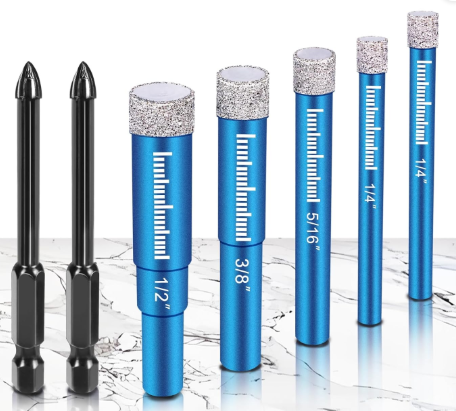
Product Description
The Samest 7-Piece Dry Diamond Drill Bits Set is designed for ceramic, glass, porcelain, marble, granite, and stone drilling. The set includes various sizes: 2 pcs of ¼-inch, then one each 5/16″, 3/8″, ½” diamond drills plus (2) cross-drills for positioning. Unique feature: solid cooling wax integrated into the bit so that initial drilling can be done dry (i.e. no external water), which helps with convenience. When the wax wears out, wet drilling is still possible. Bits have round shank, compatible with most common drills.
Key Features
- Sizes: ¼”, 5/16″, 3/8″, ½”, plus positioning cross drills.
- Dry diamond tooling with cooling wax embedded for initial friction reduction.
- Round shank for compatibility with standard drills.
- Suitable for multiple materials: glass, porcelain, ceramic, marble, stone.
Pros
- Dry initial drilling is more convenient—don’t have to always use a water source.
- Diamonds maintain sharper cutting edges and give cleaner holes generally.
- Multiple size options provide flexibility.
- Cross drills help start holes without slipping.
Cons
- Embedded wax only helps during early use; once worn, you’ll need to manage cooling (wet); ignoring this can damage bits or material.
- Dry drilling even with wax tends to wear bits quicker than wet drilling.
- Smaller sizes only—large holes still require hole saws or larger diamond saws.
- More fragile tip and edges; need careful handling.
Recommendation
Good middle-ground choice if you want diamond performance without always dealing with wet drilling. Especially useful if you occasionally drill tile, glass etc., but not doing large holes. Keep extra protection for bits after wax is used up, and always cool when needed.
4. MARSBASE Diamond Hole Saw Tile Drill Bits Kit, 10-pcs Serrated Brazed Dry Diamond Hole Saw Set with EVA Guide Jig
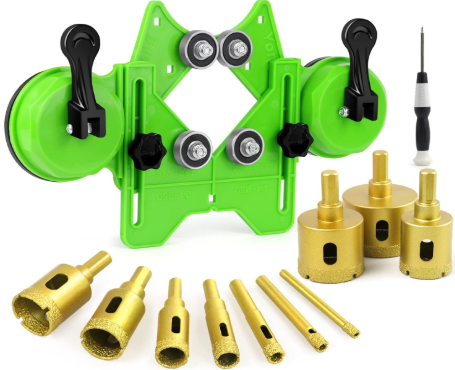
Product Description
The MARSBASE 10-Piece Diamond Hole Saw Kit offers a full suite of hole saws for ceramic, glass, porcelain, marble, granite, terrazzo, etc. Sizes range from small (~¼”) up to 2″ (or larger depending on model). Key features include a serrated brazed diamond edge for cutting, anti-corrosion electroplating on surfaces, and multiple chip removal grooves to help evacuate debris. The kit also includes an EVA mold guide jig (a positional guide) to help keep holes straight and prevent slipping, plus a storage bag. The hole saws are dry-usable (though wet helps longevity) and designed to handle dual purposes. Meant for hole openings rather than single screw‐size holes.
Key Features
- 10 brazed diamond hole saw sizes up to ~50mm (≈2″).
- Serrated top edge + chip/groove design for faster dust removal.
- EVA mold guide jig (clamp or guide) for positioning the hole saw.
- Dual-use dry/wet capacity; surface treatments for rust/anti-corrosion.
- Storage bag included.
Pros
- Great range of large hole sizes so it’s very useful for plumbing, fixture cutouts, etc.
- Guide jig helps prevent slipping, which is a major problem when starting big holes on smooth tile.
- Serrated design helps with debris removal, which improves cutting efficiency.
- Dry use capability adds convenience; wet use extends life.
Cons
- Larger hole saws require more power/torque; smaller drills may struggle or bind.
- Dry drilling at larger size creates a lot of heat; without good cooling, cuts may burn tile or shorten bit life.
- Bulky set; storage and transport heavier.
- Expensive compared to small sets; might be overkill for occasional small jobs.
Recommendation
Excellent pick if you’ll be creating larger holes (pipes, lights, fixtures) through tile or stone. If you have a powerful drill and sometimes do plumbing or major remodeling, this set gives you much of what you need. For light jobs or single hole tasks, you might choose a simpler/dedicated size to save cost.
5. BGTEC Dry Diamond Drill Bits with Quick-Change Hex (5-piece)
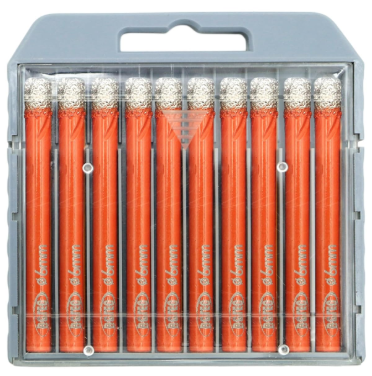
Product Description
The BGTEC 5-piece Dry Diamond Drill Bits set features smaller diameter bits around ¼-inch size (≈6mm), designed for drilling ceramic, porcelain, tile, stone, etc. They have a hex shank for quick-change systems, making swapping bits faster and more secure in some drills. They are for dry drilling. The total length per bit is ~66mm, give or take, giving you some depth. Though primarily for smaller holes, their design is good quality diamond tips and suitable for frequent use.
Key Features
- Set of 5 diamond drill bits of approx ¼-inch size each.
- Quick-change hex shank design to make bit changes faster.
- Dry drilling design (diamond tips).
- Usable on multiple materials like tile, stone, porcelain.
Pros
- Hex shank makes changing bits easier and more secure.
- Diamond tips give cleaner holes and more durability than carbide, especially in hard tile or frequent use.
- Compact set with smaller hole sizes good for screws, anchors, decorative holes.
- Dry use means less mess and simpler setup in many cases.
Cons
- Limited to smaller diameters; not useful for large hole cutting.
- Dry drilling causes heat; may need to stop periodically or use cooling methods.
- Bits may wear out faster if drilling many holes or through thick tile.
- Higher cost per bit compared to basic carbide tips.
Recommendation
Great if you need good small-hole performance and want fast bit changes (hex shank). Perfect for drilling anchors, screws, decorative holes in ceramic tile or porcelain. If you need larger holes, you’ll still need a hole saw.
6. Diamond Drill Bits Set, 10-PCS Diamond Hole Saw Set, Glass Drill Bit for Ceramic Tile Porcelain Marble Granite Stone Bottles (10-pc hole saws)
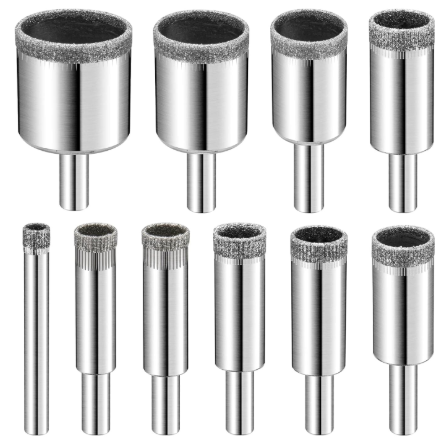
Product Description
This is a 10-piece hole saw set designed for a variety of hard, brittle surfaces: ceramic tile, porcelain, marble, granite, stone, even glass bottles. The set contains multiple core bit sizes, intended primarily for dry drilling (though, again, wet will help). The diamond coating helps with faster cutting and cleaner edges. The variety of sizes gives flexibility for different tasks—e.g. cutout holes for pipe work, hardware, fixtures. The bits generally have round shanks compatible with standard drill chucks.
Key Features
- 10 core hole saw sizes in one set.
- Diamond coating for cutting edges.
- Compatible with multiple materials (ceramic tile, marble, stone, etc.).
- Designed for dry drilling; typical use for smaller or medium hole sizes.
Pros
- Variety of sizes gives greater flexibility.
- Diamond edges tend to produce cleaner edges / less chipping when used properly.
- Good for one stop solution if your project has multiple sized holes.
- Often priced well per hole saw, given how much material these can cut through.
Cons
- As with all multi-size kits, the larger hole saws require more power and cooling.
- Dry drilling likely to produce more heat, potentially damage material or bit if overused without cooling.
- May need water or lubricant to extend lifespan.
- The larger the bit, the more torque required; small drills may struggle with binding or spinning.
Recommendation
This 10-pc hole saw set is good if you have a project with multiple hole sizes in tile, stone, or similar surfaces. It’s cost-efficient vs buying individual saws. Make sure your drill can handle the bit sizes you’ll use, and have a plan for cooling (water or intermittent drilling) to protect tile and bits.
If you want, I can also pull together a comparison table of these six sets (prices, size ranges, best applications), or filter for ones that work well for porcelain tile specifically (which is often harder).
How to Use Drill Bits for Ceramic Tile
Drilling through ceramic tile takes a bit of patience and the right approach. Here’s a step-by-step method to get clean, professional results without cracking your tile.
1. Prep the Surface
- Clean the tile surface to remove dust, grease, or soap residue.
- Use a pencil or marker to mark where you want your hole.
- For extra grip, place a small piece of masking tape or painter’s tape over the mark—this helps prevent the bit from wandering on the slick surface.
2. Choose the Right Bit
- For small holes (anchors, screws, towel racks), use a carbide spear-point bit.
- For large holes (pipes, outlets, shower fittings), use a diamond hole saw or core drill bit.
- Make sure the bit matches the diameter you need—don’t try to “widen” a hole with side pressure, as that can crack tile.
3. Set Up Your Drill
- Fit the drill bit securely in the chuck.
- Turn off hammer mode—ceramic tiles will crack instantly under impact.
- Use the lowest RPM setting on your drill. Slow, steady drilling is key.
4. Start the Hole Slowly
- Hold the drill at a slight angle when you first touch the bit to the tile.
- Once the bit “bites” into the glaze, straighten the drill and continue at low speed.
- Apply light, steady pressure—let the bit do the cutting.
5. Keep It Cool
- Drilling generates heat, which can dull bits and damage tiles.
- Use a spray bottle, wet sponge, or running water to cool the bit as you drill.
- For diamond bits with wax cores, the wax provides initial cooling, but water still extends life.
6. Finish the Hole
- Once you’ve penetrated the glaze layer, drilling becomes easier.
- Keep the drill straight until the bit passes all the way through the tile.
- Clear dust and debris between passes if needed.
Safety Guide for Drilling Ceramic Tile
Working with tiles can be safe and smooth if you follow some basic precautions.
✅ Do’s
- Wear safety glasses: Tiny shards can fly off during drilling.
- Use gloves: Protects your hands from sharp tile edges and slipping tools.
- Secure the area: If drilling on a wall, make sure it’s backed by solid material (not hollow voids).
- Check behind the tile: Ensure no electrical wires or plumbing lines are directly behind your mark.
- Cool the bit: Always have water nearby to reduce heat and extend tool life.
❌ Don’ts
- ❌ Don’t use hammer drill mode—it will almost always crack tile.
- ❌ Don’t rush—fast speeds and hard pressure increase breakage risk.
- ❌ Don’t use dull or damaged bits—they slip easily and may shatter the tile.
- ❌ Don’t drill without marking—precision is crucial on brittle surfaces.
- ❌ Don’t ignore cooling—even “dry” bits benefit from water.
Pro Tips for Best Results
- Start with a pilot hole when making large cutouts, then switch to a bigger bit.
- Keep a steady hand—any wobble can chip the glaze.
- Drill halfway from one side, then finish from the back when possible, to avoid exit chipping.
- If drilling many holes, rotate between two bits to let one cool while using the other.
👉 With the right bit, proper technique, and these safety steps, you’ll drill clean, crack-free holes in ceramic tile like a pro.
FAQs About Drilling Ceramic Tile
Q1. Can I use a regular drill bit on ceramic tile?
No—standard wood or metal drill bits won’t cut through ceramic tile effectively. They’ll either slip across the surface or overheat quickly. Always use carbide-tipped spear-point bits or diamond-coated bits designed specifically for tile.
Q2. Do I need a special drill for ceramic tile?
Not necessarily. A regular corded or cordless drill works fine, as long as it allows you to adjust the speed. Avoid hammer drills unless you’re drilling into the wall substrate behind the tile (never on the tile itself).
Q3. How do I prevent the tile from cracking?
Use the lowest speed setting, apply light pressure, and always cool the bit with water. Starting with masking tape over your drill point also helps prevent slipping that can cause cracks.
Q4. Which is better for ceramic tile: carbide or diamond drill bits?
- Carbide bits are budget-friendly and good for softer ceramic tiles or small jobs.
- Diamond bits are stronger, faster, and last longer—especially if you’re drilling through harder materials like porcelain or doing multiple holes.
Q5. How long will a ceramic tile drill bit last?
That depends on the material, tile hardness, and how well you cool the bit. A carbide bit may last for just a handful of holes in ceramic, while a high-quality diamond bit can last for dozens of holes when properly cooled.
Q6. Can I drill into porcelain tile with these bits?
Yes—but porcelain is much denser than ceramic. If you’re drilling porcelain, diamond drill bits are highly recommended. Carbide bits may work for very light jobs but won’t last long.
Q7. What size bit do I need for wall anchors?
Most standard wall anchors for shelves, hooks, or racks require ¼” or ⅜” bits. Always check your anchor’s packaging for the exact size needed.
Conclusion
Drilling into ceramic tile can feel intimidating, but with the right tools and techniques, it doesn’t have to be. Choosing the best bit for drilling ceramic tile—whether it’s a cost-effective carbide spear-point for quick jobs or a durable diamond-coated bit for professional results—makes all the difference in your project’s outcome.
By taking your time, keeping your drill steady, and cooling the bit, you’ll avoid cracks, chips, and wasted tiles. Whether you’re installing bathroom fixtures, cutting holes for plumbing, or mounting shelves in the kitchen, the right drill bit ensures clean, precise holes every time.
Investing in quality now means fewer headaches later—so pick the bit that matches your project, follow the safety steps, and you’ll be ready to drill ceramic tile like a pro.